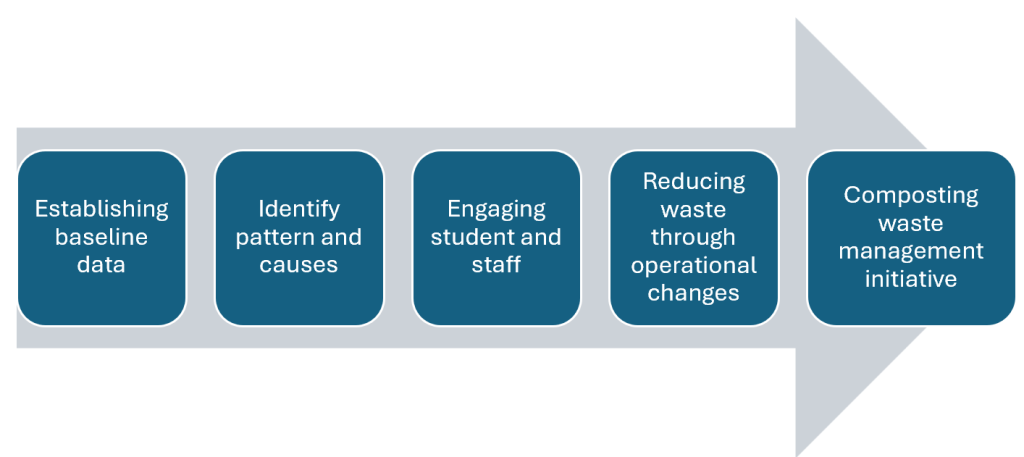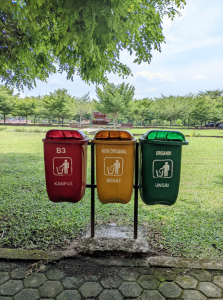
SDG 2 – Indicator 2.2.1 – Campus food waste tracking
Tracking Food Waste at the Universitas Sriwijaya
Indonesia is among the world’s largest contributors to food waste, discarding around 300 kg of food per person annually. Food waste and food loss together are estimated to cost Indonesia billions of dollars each year. The waste includes fresh produce, grains, and prepared foods, exacerbating environmental issues such as greenhouse gas emissions from decomposing organic waste in landfills.
The food waste problem in Indonesia is complex. It occurs at both ends of the supply chain, during production (losses from harvesting and storage) and at the consumer level (leftovers and discarded foods).
Measuring food waste at Sriwijaya University requires a combination of quantitative and qualitative methods. The university can make meaningful progress in reducing food waste and promoting sustainability by collecting data on the amount of food wasted, analyzing patterns, and implementing targeted interventions. The overall goal is not only to reduce waste, but also to raise awareness of the impact of food waste and promote a culture of sustainability on campus.
The amount of food waste depends on the population of the community. Each individual needs to eat. However, to calculate the amount of waste in diverse communities is a difficult challenge. The work culture in universities is different from the work system in government and production activities in industrial environments. The academic community sometimes must work on Saturdays and Sundays, during normal business hours, working on and/or off campus. Food waste is a particularly troubling issue when viewed against the backdrop of food insecurity. In South Sumatra, as in other parts of Indonesia, there are areas where food access is limited, yet significant quantities of food are lost or wasted along the supply chain.
Sriwijaya University takes part in controlling food waste and has long been running a food waste tracking system in the campus environment. The food waste tracking system at Sriwijaya University uses the following approach:

- Establish Baseline Data
The first step is to measure current levels of food waste across dining halls, cafeterias, and events on campus. This includes tracking both pre-consumer waste (from preparation) and post-consumer waste (leftovers on students’ plates).
- Analyzing Data to Identify Patterns and Causes
Tracking data is collected, analyse it to pinpoint common sources and types of waste. For example, if the data shows high levels of leftover vegetables, the university can adjust portion sizes or alter menus to offer popular, seasonal dishes that are less likely to be left uneaten. Identify specific times when food waste spikes, such as end-of-semester events or weekends, and tailor strategies to mitigate these peak waste periods.
- Engaging Students and Staff
Educational Campaigns: Universities have run campaigns to educate students on the impacts of food waste and ways to reduce it. Integrating food waste education into orientation or sustainability classes can help embed these values into campus culture. Incentive Programs: Offering incentives, such as discounts for students who take smaller portions or use reusable containers, can motivate students to be more mindful of waste. Student-Led Initiatives: Forming student groups focused on sustainability and food waste reduction can increase involvement and bring innovative ideas. Students can also participate in food audits, helping with tracking efforts and raising awareness among peers.
- Reducing Waste through Operational Changes
Portion Control: Based on data from the tracking system, Dining service during some events (Conferences, Meetings, exams, etc.) has adjusted portion sizes or offered flexible portion options. Smaller portions with the option for second servings can help cut down on plate waste. Menu Adjustments: If certain items consistently result in waste, the university has adjusted menus to remove or replace them. Focusing on seasonal, in-demand items that are more likely to be consumed can also reduce waste. Pre-Order Systems: Implementing a pre-order system, where students order their meals in advance, can help dining services prepare only the necessary quantities, thereby reducing waste from overproduction.
- Composting and Waste Management Initiatives
Composting Programs: For food waste that is unavoidable, such as scraps and peelings, universities can establish composting programs. This reduces waste sent to landfills and produces compost that can be used for campus landscaping or community gardens. Waste Separation Bins: Setting up designated bins for organic waste can make composting easier and improve waste management efficiency. These bins can be placed in cafeterias and dining halls with clear signage to encourage proper disposal.
Sriwijaya University provides healthy campus platform website and YouTube to educate students and staff about food waste and its environmental and economic impact.

Link:
